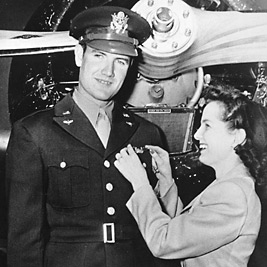


Decent guy, Pearl Harbor volunteer. Many dangerous missions over Europe. Don't agree with his politics but his character is in contrast to the current Libs like Kieth Ellison, Barney Frank, Saturday Night Live Senator, Hussein Obama and Senile Joe Biden.
McGovern was listening to a radio broadcast of the New York Philharmonic Orchestra for a sophomore-year music appreciation class when he heard the news of the December 7, 1941, attack on Pearl Harbor.[23] Within days he drove to Omaha, Nebraska, and volunteered to join the United States Army Air Forces.[4][23] The military accepted him, but they did not yet have enough airfields, aircraft, or instructors to start training all the volunteers, so McGovern stayed at Dakota Wesleyan.[21] George and Eleanor became engaged, but initially decided not to marry until the war was over.[21] During his sophomore year, McGovern won the statewide intercollegiate South Dakota Peace Oratory Contest with a speech called "My Brother's Keeper", which was later selected by the National Council of Churches as one of the nation's twelve best orations of 1942.[3][24] McGovern was also elected president of his sophomore and junior classes.[1] In February 1943, during his junior year, he and a partner won a national debate tournament at North Dakota State University that featured competitors from over one hundred schools; upon his return to campus, he discovered that the Army had finally called him up.[20]
[edit]
Military service
Soon thereafter McGovern was sworn in as a private at Fort Snelling in Minnesota.[25]
Starting on November 11, 1944, McGovern flew 35 missions over enemy territory from San Giovanni, the first five as co-pilot for an experienced crew and the rest as pilot for his own plane, known as the Dakota Queen after his wife Eleanor.[38] His targets were in Austria; Czechoslovakia; Germany; Hungary; Poland; and northern, German-controlled Italy, and were often either oil refinery complexes or rail marshalling yards, all as part of the U.S. strategic bombing campaign in Europe. The eight- or nine-hour missions were grueling tests of endurance for pilots and crew, and while German fighter aircraft were a diminished threat by this time as compared to earlier in the war, his missions often faced heavy anti-aircraft artillery fire that filled the sky with flak bursts.
On McGovern's December 15 mission over Linz, his second as pilot, a piece of shrapnel from flak came through the windshield and missed fatally wounding him by only a few inches.[39] The following day on a mission to Brüx, he nearly collided with another bomber during close-formation flying in complete cloud cover.[40] The following day, he was recommended for a medal after surviving a blown wheel on the always-dangerous B-24 take-off, completing a mission over Germany, and then landing without further damage to the plane.[41] On a December 20 mission against the Škoda Works at Pilsen, Czechoslovakia, McGovern's plane had one engine out and another in flames after being hit by flak. Unable to return to Italy, McGovern flew to a British airfield on Vis, a small island in the Adriatic Sea off the Yugoslav coast that was controlled by Josip Broz Tito's Partisans. The short field, normally used by small fighter planes, was so unforgiving to four-engined aircraft that many of the bomber crews who tried to make emergency landings there perished. But McGovern successfully landed, saving his crew, a feat for which he was awarded the Distinguished Flying Cross.[42][43]
In January 1945, McGovern used R&R time to see every sight that he could in Rome, and to participate in an audience with the Pope.[44] Bad weather prevented many missions from being carried out during the winter, and during such downtime McGovern spent much time reading and discussing how the war had come about. He resolved that if he survived it, he would become a history professor.[45] In February, McGovern was promoted to First Lieutenant.[46] On March 14, McGovern had an incident over Austria in which he accidentally bombed a family farmhouse when a jammed bomb improvidentally released above the structure and destroyed it, an event which haunted McGovern.[47] (Four decades later, after a McGovern public appearance in that country, the owner of the farm approached the media to let the Senator know that he was the victim of that incident but that no one had been hurt and the farmer felt that it had been worth the price if that event helped achieve the defeat of Nazi Germany in some small way. McGovern was greatly relieved.[48][49]) On returning to base from the flight, McGovern was told his first child Ann had been born four days earlier.[47] April 25 saw McGovern's 35th mission, which marked the fulfillment the Fifteenth Air Force requirement for a combat tour, against heavily defended Linz. The sky turned black and red with flak – McGovern later said "Hell can't be any worse than that" – and the Dakota Queen was hit multiple times, resulting in 110 holes in its fuselage and wings and an inoperative hydraulic system. McGovern's waist gunner was injured, and his flight engineer was so unnerved by his experience that he would subsequently be hospitalized with battle fatigue, but McGovern managed to bring back the plane safely with the assistance of an improvised landing technique.[43][50]
In May and June 1945, following the end of the European war, McGovern flew food relief flights to northern Italy, then flew back to the United States with his crew.[51] McGovern was discharged from the Army Air Forces in July 1945, with the rank of First Lieutenant.[1] He was also awarded the Air Medal with three oak leaf clusters,[3] one instance of which was for the safe landing on his final mission.[52]


